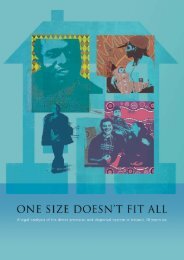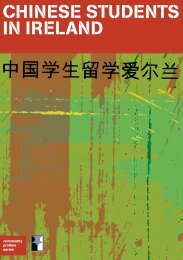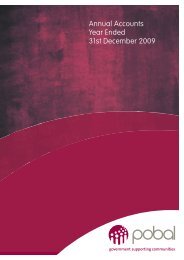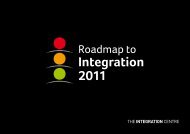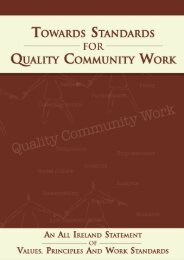Most students do not want <strong>in</strong>tentionally tohurt o<strong>the</strong>rs, and, with this rem<strong>in</strong>der, <strong>the</strong>ymay strive to couch <strong>the</strong>ir comments <strong>in</strong> less<strong>in</strong>flammatory language.F<strong>in</strong>d out what students know and th<strong>in</strong>kabout an issue before beg<strong>in</strong>n<strong>in</strong>g an <strong>in</strong>quiryF<strong>in</strong>d out what <strong>the</strong>y know about an issue,what <strong>the</strong>y th<strong>in</strong>k <strong>the</strong>y know but aren't sureabout, where <strong>the</strong>ir <strong>in</strong>formation comesfrom, and what questions <strong>the</strong>y have. Theirresponses can come from directquestion<strong>in</strong>g, bra<strong>in</strong>storm<strong>in</strong>g, groupdiscussions, and journal-writ<strong>in</strong>g.Expose students to multiple perspectivesAvoid classroom discussions on issues untilstudents have had an opportunity toresearch and explore <strong>the</strong> issue from avariety of perspectives. But remember,exposure to different po<strong>in</strong>ts of view on acontroversial issue is necessary but<strong>in</strong>sufficient. Students may listen, view, orread only to support what <strong>the</strong>y alreadyth<strong>in</strong>k or to f<strong>in</strong>d flaws, omissions,mis<strong>in</strong>formation.A key habit of m<strong>in</strong>d <strong>the</strong> teacher seeks todevelop through <strong>the</strong>se processes is ‘criticalopenness’–both a disposition to be openm<strong>in</strong>dedto o<strong>the</strong>rs' views and <strong>the</strong> ability tosubject <strong>the</strong>m to critical study, both <strong>the</strong>will<strong>in</strong>gness to suspend judgment and <strong>the</strong>ability ultimately to reach reasonedconclusions that are open to change.Promote dialogue and active listen<strong>in</strong>gStudents usually need help <strong>in</strong>understand<strong>in</strong>g <strong>the</strong> differences betweendialogue and debate. Dialogue aims forunderstand<strong>in</strong>g, enlargement of view,complicat<strong>in</strong>g one's th<strong>in</strong>k<strong>in</strong>g, an opennessto change. Dialogue requires real listen<strong>in</strong>g.It also requires humility.How can I dialogue if I always projectignorance onto o<strong>the</strong>rs and never perceivemy own? How can I dialogue if I am closedto, and even offended by, <strong>the</strong> contributionof o<strong>the</strong>rs?(Paulo Freire, Pedagogy of <strong>the</strong> Oppressed.)An excellent way to promote listen<strong>in</strong>g isby ask<strong>in</strong>g students to re-state <strong>the</strong>perspective of o<strong>the</strong>rs. Have <strong>the</strong>mparaphrase what <strong>the</strong>y hear ano<strong>the</strong>rstudent say<strong>in</strong>g to ga<strong>in</strong> this skill.Use active learn<strong>in</strong>g methodologiesStudents learn best when actively engaged<strong>in</strong> <strong>the</strong> learn<strong>in</strong>g. In teach<strong>in</strong>g controversialissues it is important to provideopportunities for various k<strong>in</strong>ds of groupdiscussions: pairs, conversation circles,panels, fishbowls. In addition activelearn<strong>in</strong>g methodologies can be useful <strong>in</strong>build<strong>in</strong>g empathy (e.g. role-play) and <strong>in</strong>challeng<strong>in</strong>g strongly held prejudices (e.g. asimulation game).Promote critical th<strong>in</strong>k<strong>in</strong>gPromote skills of critical evaluation andencourage students to <strong>in</strong>terrogate<strong>in</strong>formation, its orig<strong>in</strong>s and possible biases.Ask critical question to help students tounderstand <strong>the</strong> orig<strong>in</strong>s of <strong>the</strong>ir ideas andattitudes.Some examples of critical question<strong>in</strong>g• What is your current understand<strong>in</strong>g of(state issue)?• Why do you th<strong>in</strong>k/feel that way?• Where have your perceptions andunderstand<strong>in</strong>g come from?• How reliable is this <strong>in</strong>formation?• Where have your images come from?• What might be <strong>the</strong> role of <strong>the</strong> media <strong>in</strong><strong>in</strong>fluenc<strong>in</strong>g how you see this situation?• What about o<strong>the</strong>r <strong>in</strong>fluences – friends,family, religion?• Can you imag<strong>in</strong>e an alternative way ofsee<strong>in</strong>g this issue? What might it be like?84<strong>Intercultural</strong> <strong>Education</strong> <strong>in</strong> <strong>the</strong> <strong>Post</strong>-<strong>Primary</strong> <strong>School</strong>
APPROACHES AND METHODOLOGIES 6When deal<strong>in</strong>g with controversial issues,teachers should adopt strategies that teachstudents how to recognise bias, how toevaluate evidence put before <strong>the</strong>m andhow to look for alternative <strong>in</strong>terpretations,viewpo<strong>in</strong>ts and sources of evidence, aboveall to give good reasons for everyth<strong>in</strong>g <strong>the</strong>ysay and do, and to expect good reasons tobe given by o<strong>the</strong>rs.(Bailey, 1998)The teacher’s role <strong>in</strong> deal<strong>in</strong>g withcontroversial issues1. Exam<strong>in</strong>e yourselfWhat do you, <strong>the</strong> teacher, th<strong>in</strong>k and feelabout an issue? Why? Would you tellstudents at <strong>the</strong> outset what your viewsare so that <strong>the</strong>y can allow for possiblebiases? Or should you not tell <strong>the</strong>m, butguard aga<strong>in</strong>st any <strong>in</strong>cl<strong>in</strong>ations tomanipulate and propagandise?2. Be responsive to students' feel<strong>in</strong>gsand valuesvalues are likely to be revealed, forexam<strong>in</strong><strong>in</strong>g a controversial issue is not abloodless exercise. Just as <strong>the</strong> teacher'srole is not to tell students what to th<strong>in</strong>kbut to help <strong>the</strong>m learn how to th<strong>in</strong>k, sothat role is not to tell students whatfeel<strong>in</strong>gs and values to have but topromote an atmosphere <strong>in</strong> which <strong>the</strong>ycan express <strong>the</strong>m without fear, make<strong>the</strong>m explicit to <strong>the</strong>mselves, andconsider <strong>the</strong>ir validity.3. Model respect and fairnessShow respect for all students and <strong>the</strong>irright to express <strong>the</strong>ir views. Showbalance <strong>in</strong> represent<strong>in</strong>g oppos<strong>in</strong>gpositions accurately and fairly.The teacher cannot pretend to beneutral and has a right to express anop<strong>in</strong>ion too. But it is important to stateone’s own op<strong>in</strong>ion <strong>in</strong> a way thatrespects o<strong>the</strong>rs and does not serve toclose down <strong>the</strong> discussion.Through such techniques as thoseoutl<strong>in</strong>ed above, students' feel<strong>in</strong>gs and<strong>Intercultural</strong> <strong>Education</strong> <strong>in</strong> <strong>the</strong> <strong>Post</strong>-<strong>Primary</strong> <strong>School</strong> 85








